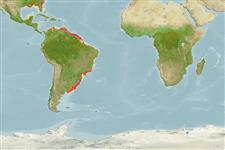Elasmobranchii (tubarões e raias) (sharks and rays) >
Myliobatiformes (Stingrays) >
Myliobatidae (Eagle and manta rays)
Etymology: Myliobatis: Greek, mylo = mill + Greek, + Greek, batis,-idos = a ray (Raja sp.) (Ref. 45335).
Eponymy: Dr George Brown Goode (1851–1896) was an American ichthyologist and museum administrator at the Smithsonian. [...] (Ref. 128868), visit book page.
More on author: Garman.
Environment: milieu / climate zone / depth range / distribution range
Ecologia
marinhas bentopelágico; intervalo de profundidade 1 - 130 m (Ref. 57911). Tropical; 33°N - 40°S, 180°W - 180°E
Worldwide in tropical waters. Western Atlantic: South Carolina, USA to Argentina. Often confused with Myliobatis freminvillii.
Tamanho / Peso / Idade
Maturity: Lm ? range ? - ? cm
Max length : 125 cm TL macho/indeterminado; (Ref. 57911); common length : 80.0 cm WD macho/indeterminado; (Ref. 6077)
Smaller dorsal fin set farther back on tail, well beyond the pelvic fins. Disk broader, with more rounded corners of wings. Snout less projecting. No spines on disk (Ref. 7251). Broader separation between the inner ends of gill openings. Chocolate or greyish brown above and brownish white below (Ref. 6902).
Ovoviviparous (Ref. 50449). In coastal waters down to 130 m.
Life cycle and mating behavior
Maturidade | Reprodução | Desova | Ovos | Fecundidade | Larvas
Exhibit ovoviparity (aplacental viviparity), with embryos feeding initially on yolk, then receiving additional nourishment from the mother by indirect absorption of uterine fluid enriched with mucus, fat or protein through specialised structures (Ref. 50449).
Robins, C.R. and G.C. Ray, 1986. A field guide to Atlantic coast fishes of North America. Houghton Mifflin Company, Boston, U.S.A. 354 p. (Ref. 7251)
Categoria na Lista Vermelha da IUCN (Ref. 130435: Version 2024-1)
Ameaça para o homem
Harmless
Utilização humana
Pescarias: pouco comercial
Ferramentas
Relatórios especiais
Descarregue XML
Fontes da internet
Estimates based on models
Preferred temperature (Ref.
123201): 13.3 - 27.8, mean 24.4 °C (based on 732 cells).
Phylogenetic diversity index (Ref.
82804): PD
50 = 0.5002 [Uniqueness, from 0.5 = low to 2.0 = high].
Bayesian length-weight: a=0.00389 (0.00119 - 0.01269), b=3.08 (2.83 - 3.33), in cm total length, based on LWR estimates for this (Sub)family-body shape (Ref.
93245).
Nível Trófico (Ref.
69278): 3.3 ±0.34 se; based on food items.
Resiliência (Ref.
120179): Muito baixo, tempo mínimo de duplicação da população maior que 14 anos (Fec assumed to be <10).
Fishing Vulnerability (Ref.
59153): High to very high vulnerability (75 of 100).
Nutrients (Ref.
124155): Calcium = 22.5 [6.6, 112.7] mg/100g; Iron = 0.637 [0.161, 1.754] mg/100g; Protein = 20.6 [15.6, 25.8] %; Omega3 = 0.153 [0.043, 0.476] g/100g; Selenium = 61.5 [15.7, 183.1] μg/100g; VitaminA = 14.3 [5.5, 36.8] μg/100g; Zinc = 0.875 [0.426, 1.585] mg/100g (wet weight);
